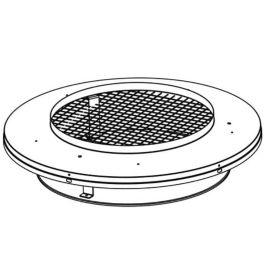Help!😩Smoke Billows in Room! NEW Majestic Biltmore 42”
- Thread starter No More Smoke-Shows:(
- Start date
-
Active since 1995, Hearth.com is THE place on the internet for free information and advice about wood stoves, pellet stoves and other energy saving equipment.
We strive to provide opinions, articles, discussions and history related to Hearth Products and in a more general sense, energy issues.
We promote the EFFICIENT, RESPONSIBLE, CLEAN and SAFE use of all fuels, whether renewable or fossil.
You are using an out of date browser. It may not display this or other websites correctly.
You should upgrade or use an alternative browser.
You should upgrade or use an alternative browser.
I dunno about this one, but some companies do say to measure chimney height from the flooryour fireplace requires 18 to 90 ft flue you're measuring from the floor but I think it's a mistake, you must measure from the point where the chimney begins, your chimney is approximately 14 ft tall, and it is totally insufficient
sure, it could be but considering the latest update, that a distant window is not enough, then in this case a higher draft is really needed, lengthening the chimney, otherwise, if it may seem bad, Should consider something motorized on the roof but I don't know if they work, zero experience in this senseI dunno about this one, but some companies do say to measure chimney height from the floor
11" will flow 10X what a 4" will!11" internal diameter of flu vs that 4" combustion air pipe, might just as well leave the door open. Very likely that the orginial design of this was for a gas burner ( had one like that ) more for appeal than actual heating.
That's exactly how I've described a chimney with too much draft in the past..."open the stove door and it'd suck up nearby small pets if you're not careful"!it would be appropriate to post a sign, danger risk of suction near that external air intake😂

The manufacturer typically gives a minimum height measured from the floor of the fireplace. 12’ is common.your fireplace requires 18 to 90 ft flue you're measuring from the floor but I think it's a mistake, you must measure from the point where the chimney begins, your chimney is approximately 14 ft tall, and it is totally insufficient
It’s a wood burner that has the capability of using a gas log log or starter. Not a gas fireplace.11" internal diameter of flu vs that 4" combustion air pipe, might just as well leave the door open. Very likely that the orginial design of this was for a gas burner ( had one like that ) more for appeal than actual heating.
iheartfireplaces
New Member
New construction can be almost too air tight causing pressure issues. It is a large fireplace for a small and likely very air tight room. It also looks like you have partially below grade construction in the back. I'm wondering if that has any impact on how tall the chimney should be. Also, maybe the exterior pipe should be enclosed in an insulated chase? There are likely a couple factors at play not just one culprit. If you haven't already I would call the manufacturer tech support, send them your pictures and have them review it. I work for a chimney & fireplace company and manufacturer techs are usually very helpful.
That wouldn't change with opening a nearby window though...I'm also wondering if the cap is too restrictive
DisagreeThat wouldn't change with opening a nearby window though...
A chimney restriction is a chimney restriction...changing the amount of makeup air available isn't going to change that, might even make it worse at first.Disagree
Increasing the makeup air available is equivalent to decreasing the total system restriction which raises the room pressure by some amount, which increases the pressure differential along the chimney and increases the flow. The chimney cap is one of several components creating restrictions to the flow. Not saying it will solve the problem but chimney caps always decrease the available draft.A chimney restriction is a chimney restriction...changing the amount of makeup air available isn't going to change that, might even make it worse at first.
We have a fireplace with an undersized flue (it was lined with terra cotta after originally being unlined) and has marginal draft. Opening a window definitely helps reduce the risk of smoking even though the undersized flue is the root issue.
A larger pipe will always flow more volume, but the pressure drop will be less. In the case of a fireplace it's the volumetric flow rate vs. fireplace opening area that we care about. A large diameter chimney works better for a fireplace.I don't want to be wrong but it's the opposite,
a wide flue has a lower draft than a flue of the same height but smaller diameter,
in this case if diameter is 11 inches,
height "18 from the floor"
It's too short in proportion to draw air well
iheartfireplaces
New Member
This is a prefabricated fireplace and the flue/opening ratio has already been determined by the manufacturer and the fireplace was installed with the pipe indicated by the manufacturer. The manufacturer manual indicates a minimum of 18.5' from bottom of fireplace to top of chimney which seems to have been met. I don't think this is a proportion issue rather the lack of air flow that can be drawn from a small air tight room and the location of the chimney relative to other structures in the surrounding area.I don't want to be wrong but it's the opposite,
a wide flue has a lower draft than a flue of the same height but smaller diameter,
in this case if diameter is 11 inches,
height "18 from the floor"
It's too short in proportion to draw air well
Thanks for the input. Yes, I have reached out to the manufacturer, and they suggested increasing the chimney height to 18.5’ which we’ve now done (they did say it’s measured from floor). Also adding the smoke shield, and neither of those changed anything.
The manufacturer did also say we could try using the TR-TVK cap (the link is below.). The manufacturer said, “They can use a TR-TVK, which is used with the current cap. It makes the TR444 an open top to help with draft.” Link:

 www.fireplacesdirect.com
www.fireplacesdirect.com
My concern is with having an open top cap…. Wouldn’t we get rain and snow coming right down the chimney??
The lack of an extended insulated chimney I can’t see being the main culprit, as the fireplace smokes the same on freezing cold winter days as it does in warm summer days, and every temperature in between.
What I can’t wrap my head around is why the large window that is further away doesn’t solve any air pressure issues. In my last post, I uploaded the floorplan which shows dimensions and the window locations. It’s a large window and essentially in the same room, so I don’t understand why it still smokes even if that window is WIDE open. I need to have the closer window open in order to keep it from smoking.
I’m still waiting on the camera to arrive to rule out that vent being blocked. Also, I’ve put 4 inches of fire retardant gypsum board on each side to reduce the opening width to 34” as a test to see if having a smaller opening helps. I’ll keep you posted. Gosh, I really worry this will never be solved! I wonder if it’s worth adding even more height to the chimney to see if that helps anything? 🤯🤦🏼♀️😩
The manufacturer did also say we could try using the TR-TVK cap (the link is below.). The manufacturer said, “They can use a TR-TVK, which is used with the current cap. It makes the TR444 an open top to help with draft.” Link:

Majestic TR-TVK Round Termination Top Adapter Kit For Shrouds
The Round Termination Top Adapter Kit For Shrouds by Majestic provides a smart ventilation accessory for use with your Majestic fireplace.
My concern is with having an open top cap…. Wouldn’t we get rain and snow coming right down the chimney??
The lack of an extended insulated chimney I can’t see being the main culprit, as the fireplace smokes the same on freezing cold winter days as it does in warm summer days, and every temperature in between.
What I can’t wrap my head around is why the large window that is further away doesn’t solve any air pressure issues. In my last post, I uploaded the floorplan which shows dimensions and the window locations. It’s a large window and essentially in the same room, so I don’t understand why it still smokes even if that window is WIDE open. I need to have the closer window open in order to keep it from smoking.
I’m still waiting on the camera to arrive to rule out that vent being blocked. Also, I’ve put 4 inches of fire retardant gypsum board on each side to reduce the opening width to 34” as a test to see if having a smaller opening helps. I’ll keep you posted. Gosh, I really worry this will never be solved! I wonder if it’s worth adding even more height to the chimney to see if that helps anything? 🤯🤦🏼♀️😩
Yes. And in a hot metal steel box that sounds like an invitation for rust.My concern is with having an open top cap…. Wouldn’t we get rain and snow coming right down the chimney??
The ERV has two vents that “blow air” in the ceiling just in front of the fireplace (maybe 3-4 feet forward or so). The vent that sucks the air when the ERV is on is located in the bar area (which you can see on the floor-plan I had uploaded).
Can you partially block the return of the ERV as a test?The ERV has two vents that “blow air” in the ceiling just in front of the fireplace (maybe 3-4 feet forward or so). The vent that sucks the air when the ERV is on is located in the bar area (which you can see on the floor-plan I had uploaded).
Do the 2 windows you are opening face different directions? Is one of them closer to the house wall? Also, which side of the building are the exterior vents of the ERV located? Is there a prevailing breeze during these tests?
Similar threads
- Replies
- 14
- Views
- 300
- Replies
- 24
- Views
- 5K
- Replies
- 4
- Views
- 2K

